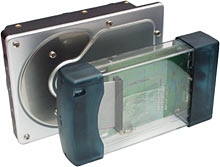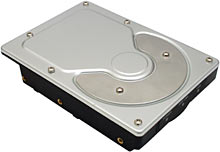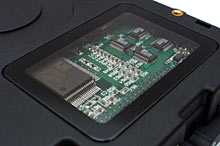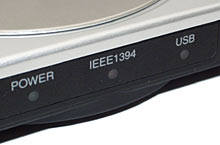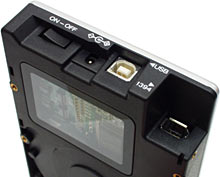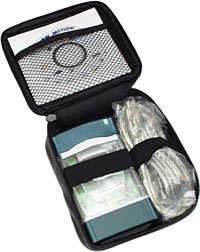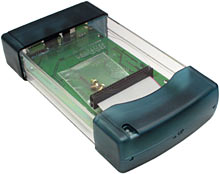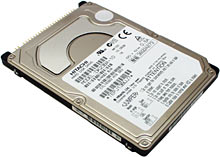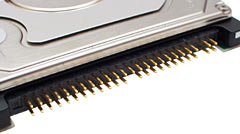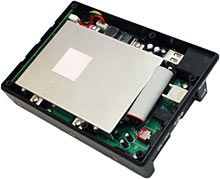
Skymaster DEN-0251 Dual Face and New Motion 2.5" Combo Enclosure
Review date: 6 December 2001.Last modified 03-Dec-2011.
If you need high capacity, high speed, high compatibility rewritable removable storage, external hard drives are where it's at.
CD-RW and the various larger capacity rewritable optical discs are all very well; once you've got the writer, the incremental media cost approaches zero for the CD formats, and isn't too terrifying for the DVD ones.
But you don't want to have to buy and install a drive that can write them in multiple computers, and external 5.25 inch devices tend towards the "transportable" end of the portability spectrum - definition: "Neither chained to a wall nor attached to an alarm system". And the larger capacity formats can't even be read by ordinary CD-ROM drives. And even the largest capacity writable DVD flavours can't hold as much data as the cheapest 3.5 inch commodity hard drives that your local computer shop's likely to stock.
There are lots of other options, of course.
Zip drives are great if you don't need to move too much data or get at it at full hard disk speed, but they're not the medium of choice for anything very substantial, by current standards.
Removable hard platter cartridge drives, like Iomega's Jaz, have better capacity and speed than Zip disks, but the cartridges are fragile and dust-sensitive (yes, I know the salesthings say that they aren't), and the price per megabyte compared with hard drives isn't exciting, and you still need a bunch of cartridges if you want to shift a mere 20Gb.
Solid state portable storage is definitely the coming thing, but it's not here yet. The smart way to do it is not with a one-piece one-purpose gadget, but with a commodity memory card and a reader/writer to match (I check out both options in my review here), but there are still price and capacity limits.
Hit the cheapie-dealers on Ebay and you can get CompactFlash memory cards for about 50 US cents per megabyte, as I write this. But if you want more than 256Mb of storage (which is going to be two hundred and forty-something real megabytes, thanks to the de rigeur capacity overestimation of which practically all storage vendors are guilty...) then the price per megabyte climbs steeply.
1Gb memory cards aren't quite on the market yet; you can find 1Gb IBM Microdrives for $US300, but if you want a gigabyte of storage with the toughness and thinness of flash memory and CompactFlash Type 1, you'll have to hang around for another month or three, and then pay the thick end of $US800. Yow.
Let's presume that none of these options totally grab you. Let's also presume that you need at least a few gigabytes of storage, preferably without any disk-swapping. Let's further presume that you don't want to have to install expensive drives in multiple computers, would like your storage gadget to fit in your pocket, and want to be able to dump, say, a 2Gb backup onto it in the time it takes you to wash your coffee cup at the end of the work day.
What you want, in this situation, is a hard drive in an external box with a fast plug-and-play interface, like USB 2.0 or IEEE-1394 (FireWire). The hard drive's actually an IDE unit, but "bridge" hardware in the box translates to and from IDE-speak, allowing the drive to behave as a USB or FireWire storage device.
The cheapest way to do this is by using a 3.5 inch half height commodity IDE drive, as used in desktop PCs. One of those drives in an external case won't really be pocket-sized, and commodity drives don't like being dropped, but you can't beat the price per megabyte.
If a drive capacity of 5 to 20Gb is OK with you, though, and you don't mind paying a bit more per megabyte for smaller size and more durability, then 2.5 inch laptop IDE drives are a much more elegant solution.
2.5 inch drives are used by pretty much every portable computer on the market today. They're much more compact than 3.5 inch units, but they're not really magically small, like a Microdrive; stack a pair of 2.5 inchers on top of each other and they're about the size of a pack of cards.
2.5 inch drives are made for low power operation, so they can run from USB or FireWire power, without a separate power supply. They're also made to tolerate much more shock than desktop drives, which is a nice thing for portable storage. And 2.5 inchers aren't as terrifyingly expensive as smaller drives, like the 1.8 inchers in really tiny PCs and PC Card (PCMCIA) plug-in drives.
Apple's $US399 iPod contains a 5Gb 1.8 inch drive. A 5Gb 1.8 inch drive by itself currently retails for $US300 to $US400. So, if you're feeling slightly charitable, it's possible to view the rest of the iPod as being a free gift.
For comparison, the low price for a 20Gb 9.5mm thick 2.5 inch 4200RPM notebook drive in the States at the moment is down around $US100, from the "Oh - you want it in an anti-static bag? That's $20 extra!" dealers that inhabit the bottom end of every Price Watch search. Here in Australia, you're likely to be looking at more than $AU200 for a 10Gb drive and more than $AU300 for 20Gb, ex delivery. Few dealers keep the things on the shelves, but they're easy enough to order in.
Now, $AU300 will buy you a 40Gb 3.5 inch drive, but twice the money for half the capacity and roughly a sixth of the size isn't a bad deal, if you ask me.
Now, you need a box to put your drive in.
Here are two good options.
The thing in the background that looks like a 3.5 inch drive isn't; it's Skymaster's DEN-0251 "Dual Face" drive box. They've styled it to imitate a 3.5 inch half height drive, mainly just for giggles, as far as I can see.
The thing in the foreground is New Motion's 2.5" Combo Enclosure, which can be had in boring opaque plastic, but is also available in this nifty clear version. Hey, if you've paid for a laptop drive, you might as well be able to see the thing.
Both of these boxes give you very flexible connection options, because they support both USB v1.1 and IEEE-1394 for hookup. USB 2.0 compatibility would be better than 1.1, but 1.1's not so bad.
USB version 2.0 has enough bandwidth to be used for proper hard disk tasks; 1.1 gives you less than a megabyte per second, which is OK for smaller files or when you're not in a hurry, but doesn't cut it for serious data-shifting.
Unfortunately, USB 2.0 hasn't hit critical mass yet. If you buy a USB 2.0 storage widget today, you're probably also going to have to buy a USB 2.0 controller card for every computer you want to plug the thing into. It'll work fine on USB 1.1, but only at USB 1.1 speed.
One megabyte per second is fast for USB 1.1. Dodgier USB storage solutions manage little more than half that. Want to transfer a gigabyte of data at one megabyte per second? You'll be sitting around for 17 minutes.
But every somewhat recent PC and Mac supports USB 1.1. Just being able to sit down, plug in and go is an advantage that may well outweigh the speed limit. It's not like the bad old days of parallel data transfer, after all. Parallel was, and is, about as fast as USB, but the parallel port was never meant for sustained transfers, and using it for that purpose paralyses the computer until the transfer's finished. USB transfers can chug along perfectly harmlessly in the background while you do other stuff.
IEEE-1394 has the same problem as USB 2.0, at least for IBM compatible computers. Few machines have it installed as standard, so you need to buy a controller card to add FireWire ports to a PC.
More exotic PCs and funkier laptops have FireWire ports as standard, as do recent Macs, but don't expect it to be available on some random computer.
Still, you're more likely to find FireWire ports than USB 2.0 ports, at the moment.
An external box that supports USB 1.1 and FireWire is, therefore, a perfectly realistic proposition right now, and reasonably future-proof. As long as the thing doesn't cost a fortune, it's worth buying. Neither of these boxes is terribly expensive; when I first wrote this review the Skymaster was $AU187 delivered from Aus PC Market, and the New Motion $AU203.50 delivered. However, Aus PC Market no longer sell these products (click here to see their current 2.5" external hard drive cases).
And now, those boxes in detail.
Skymaster Dual Face
Yup, that looks like a drive, all right.
The Dual Face's lid is made of aluminium, and secured with six screws around its edge. The body of the box is black plastic.
For no practical reason at all, the bottom of the Skymaster box has this little window, which shows off part of the circuit board inside.
The 3.5 inch drive styling of the Dual Face isn't completely decorative; it has mounting holes in the standard locations, so you can screw it into a computer like a normal drive, if you like. Most FireWire controller cards have an internal port as well as their external ones, so you can use them elegantly enough for internal storage - but actually doing so in this situation is a bit perverse. If you've already got a 2.5 inch hard drive, all you need is a little plug adapter kit to plug it into a PC directly via IDE. The absence of bridge hardware can only give you better performance.
Adapters to connect a 2.5 inch drive to a normal 40-pin IDE cable and power connector cost from about $AU5 to about $AU30, depending on whether they come with mounting rails to let you screw the little drive into a 3.5 inch bay, and also depending on the amount of Laptop Rip-Off Factor added by the dealer you choose.
Still, if you for some reason want to be able to mount your Dual Face in a PC or a drive rack or something as if it were a normal 3.5 inch device, you can.
If you mount the Dual Face inside another cabinet, though, these three status LEDs will go to waste. The power light is green, the 1394 activity light is amber, and the USB activity light is blue.
The connector end of the Dual Face box, with USB, FireWire and power connectors.
For normal FireWire mode, you just plug in the data cable and that's it. The drive draws power from the IEEE-1394 connection.
For USB mode, or IEEE-1394 from a tiny-connector "i.LINK" controller which lacks the power wires for normal FireWire, you have to give the Dual Face box separate power. A powered USB port (as opposed to a port on a "bus powered" hub) actually should be able to deliver enough juice to run a 2.5 inch drive, but not in this box.
The Dual Face doesn't come with a "wall wart" power supply, but it does have a passthrough PS/2 plug power cable, which delivers five volts to run the drive from any normal PC mouse or keyboard socket.
The adapter is masterfully designed such that if you plug it into a PS/2 keyboard socket, the power wire coming out of the adapter will foul the mouse socket. It works OK in the mouse socket, though.
The power switch on the back of the Dual Face box only does anything in USB mode. You can flick it all you like with the Dual Face plugged in via FireWire and nothing will happen.
The Dual Face comes with USB and FireWire cables, the power adapter, a driver CD - about which more shortly - and a couple of minuscule pamphlet-manuals. You get a fancier kit with the New Motion box.
New Motion Combo Enclosure
The New Motion box comes in this nifty zip-up case, which also contains its driver CD, and USB and FireWire cables. You also get an in-line power adapter, which you can just about stuff into the case with the other things. But this AC adapter isn't the wall wart type - it's got a computer-style IEC "jug plug" socket on one side, and you'll have your work cut out for you getting an IEC mains lead in the case as well as the rest of the gear.
That's OK, though, because the New Motion box ought to work fine from USB or FireWire power. Only bus-powered USB ports, or dodgy controllers without the full power output spec, or i.LINK systems, ought to force you to use the power adapter.
The New Motion box itself is a quite handsome thing. The clear plastic's saved from scratches by two slide-on rubber end caps, and even with the caps on it's only about 29 by 81 by 145mm (1.1 by 3.2 by 5.7 inches) in size. So it's not entirely unreasonable to describe this thing as "pocket sized"; it ain't no Zippo lighter, but you can slide it into the pocket of any pair of jeans of the non-spray-on variety and walk around without feeling as if you're trying to shoplift a two kilo block of cheese.
The Combo box has only two status lights - one for power and one for activity. They're surface mount LEDs on the main circuit board, with little light-guide poles to bring the illumination up to a cut-out in the front rubber cap.
The back panel of the New Motion has the same basic connectors as the Skymaster box, only without the power switch.
Picking your drive
All 2.5 inch hard drives are not alike, but almost all of them should work fine in these cases. Both boxes use a simple single ribbon cable to connect to the drive, and you mount the drive in the box with screws. The New Motion box comes with four mounting screws, and the Skymaster one doesn't, but that's not a big deal. 2.5 inch drives mount with ordinary floppy/CD-ROM small-pitch PC mounting screws, not anything peculiar.
The reason why you need just the one cable to hook up one of these drives is because of the special IDE connector they use.
This connector's electrically the same as the standard 40 pin IDE plug, except it's physically smaller, and there are eight more pins. The four pins in the separate block to the right of the main block of 44 pins are "vendor specific", and neither of the boxes in this review use them.
The two rightmost pairs of pins in the main 44 pin connector are the power supply contacts; the laptop IDE cable carries power as well as data, so there's no separate power plug.
Actually, the "44 pin" connector only has 43 pins, because pin 20 is the "key". It's missing, and that hole in the plug should be filled, to stop you plugging the drive in backwards.
All 2.5 inch drives have the same footprint, but they have different heights.
The Dual Face enclosure is supposed to accept 12mm thick drives, according to its specifications. 2.5 inch drives aren't actually made with a 12mm thickness, but there are 12.5 and 12.7mm thick ones. Both of those should be fine in this box, as should the ultra-slim 8.4mm models. 17mm fatties won't fit, but they're not common.
The New Motion enclosure's specifications are more precise about its limits; it'll definitely accept drives up to 12.7mm thick.
Setting up
Mounting a drive in the Dual Face box is pretty simple. Unscrew the box's lid, undo the four screws that hold the aluminium drive tray inside, mount the drive in the tray using its side screw holes, and then replace the drive tray, so that the base of the tray faces upwards, and the drive's upside down. Modern hard drives don't care what orientation they're installed in, so this isn't a problem.
To install a drive in the New Motion box, you remove the rubber end caps, and pop four plastic latches to free the top of the box. The latches are, thankfully, not the sort that force you to lever like crazy with a screwdriver and run the risk of scratching or cracking the enclosure. Those sorts of latches are common on products that aren't meant to be taken apart by the user, but they'd really suck for something that you are meant to be able to dismantle, and which is made of see-through crack-displaying plastic.
Once the lid's off, you remove a couple of screws and release one more latch to free the single circuit board; there's no separate drive holding tray. Then, you screw your drive in place through the board, using the mounting holes on the bottom of the drive. It's a bit of a tight fit, but I've seen far worse, and the holes in the board are slot-shaped to give you room to wiggle your drive into place.
Using them
If you're using an operating system that understands USB Mass Storage Devices - which includes Windows 2000, Windows ME and Windows XP - then you don't need to install a driver for either of these boxes. Just plug 'em in and, in short order, you've got a new drive.
If your operating system doesn't understand this flavour of USB drive automatically (Linux, by the way, is now meant to support USB Mass Storage Devices natively, but doesn't support as many of them as Windows does...), you'll need to install a driver from the CDs that come with the boxes.
Or not.
Don't bother with the CD that comes with the Skymaster Dual Face. The little installation leaflet tells you to point Windows to a particular directory on the multi-driver disc to find the right driver, but that directory doesn't exist, and the driver's nowhere to be found. Maybe they pack the right disc in with some DEN-251s, but they didn't pack it in with the one I got.
No matter, though; the Skymaster download page here has what you need for other Windows flavours, and USB-aware Mac OS from version 8.6 to X.
In FireWire mode, both of these boxes again Just Work on current Windows flavours, and should Just Work just as well on any other FireWire-supporting OS. Win98SE supports FireWire and shouldn't need a driver for either of these boxes in that mode, either, but if does need a patch for a selection of IEEE-1394 erratumnotbugs.
I tried both boxes out on Windows 2000, and so didn't need to fool with any drivers at all. I tried the New Motion box in USB mode first, and the fresh-from-the-anti-static-bag drive looked to Windows just like any other new unpartitioned disk. It took a few attempts to get Win2000 to successfully "write a signature" to the drive over USB (this computer has occasional... issues... with USB storage devices, so I'd be more inclined to blame it than to blame the drive), but it eventually managed it, and then partitioning and formatting via the Win2000 Disk Management interface was as simple as usual.
If you use a laptop drive that's already been partitioned and formatted with a filesystem that your operating system understands, then you won't need to bother with this step.
I tried both boxes out in USB and IEEE-1394 mode, doing simple file-copying tests to see how fast the little drive was through the bridge hardware.
When add-your-own-drive external USB boxes first started coming out, they were commonly pretty horribly slow; the USB-to-IDE bridge hardware in them was severely sub-optimal. The early cheap FireWire boxes had the same problem, though less so, because even a slow FireWire bridge is likely to be decently fast.
I'm happy to say that both of these boxes are fast in USB mode (by USB 1.1 standards, anyway), and much faster in FireWire mode.
Both boxes managed a very respectable 950-odd kilobytes per second over USB when I wrote 140Mb in 271 files to them, and about the same speed when transferring the files back to the PC again. Switching to IEEE-1394 mode on the New Motion box whipped the speed up to almost 3.8Mb per second for the write operation, and more than 7.3Mb per second for the read one. The Skymaster box did even better - its read speed was just as fast, but its write speed was almost 4.25Mb/s.
FireWire's theoretical maximum bandwidth is 400 megabits per second - about 47.7 megabytes per second - but you're not going to see anything like that from any actual storage device.
First up, not all of that theoretical bandwidth is available to even an infinitely fast storage device; some of it gets eaten by data framing and other transfer overheads.
Second, laptop hard drives aren't very fast. The data density of the higher capacity ones can be pretty impressive, but with only 4200RPM speed and, generally, not terribly high capacities, only so much data can pass under the read/write heads per second.
Third, your bandwidth depends on your disk filesystem and what you're doing with it. If you're moving tons of teeny-weeny files, there'll be a lot more disk-flogging going on than would be needed to just squirt that much data contiguously onto the drive.
The files I used for the above tests averaged about half a megabyte each. When I switched to shifting 1.7 gigabytes of data in only six files to the New Motion box in FireWire mode, the write transfer rate hopped up to more than 8.5 megabytes per second.
If you're moving lots of small files, your megabytes-per-second rate in FireWire mode won't be inspiring, but it should still beat USB by a big margin. If you're moving a few huge files, the bridge hardware hardly gets in the way at all for FireWire transfers, and you ought to be able to move about a gigabyte every two minutes.
Overall
Between the two of these, I prefer the New Motion box. It's more expensive, but it comes with a proper power supply and not a dinky adapter cable, it's genuinely pocketable, its zip-up case makes it easy to transport the box and its cables if you don't feel like putting it in your pocket, and it doesn't have the goofy disk drive styling of the Skymaster box.
Then again, maybe you want something disk drive shaped, which you can install like a normal drive. And the Skymaster box works just as well as the New Motion one.
If you already own a Rome MP3 player, another thing-that-looks-like-a-similar-but-different-thing might tickle you. And the Skymaster's dud driver disk isn't much of a shortcoming, since you can just download the drivers. You could put the $AU16.50 you save by getting the Skymaster towards a drive to put in it.
The New Motion box looks much snazzier, though, in my opinion. And the price difference isn't enough to quibble over. It gets the nod from me.
Recommended.
Skymaster's page for the Dual Face box
New Motion's page for the Combo box
Buy one!
Aus PC Market don't sell these
products any more (click
here to see their current 2.5" external hard drive cases), but you can
still try a price search at
DealTime!
